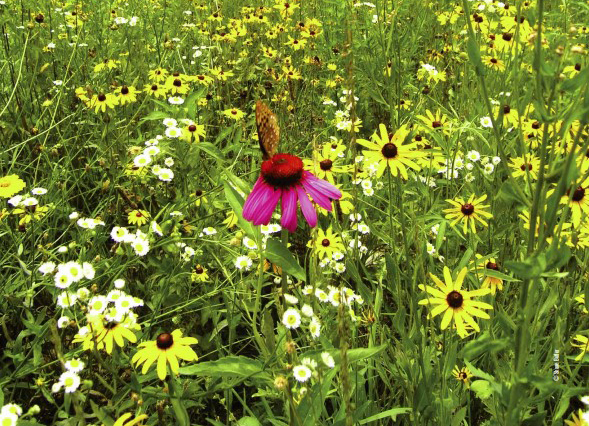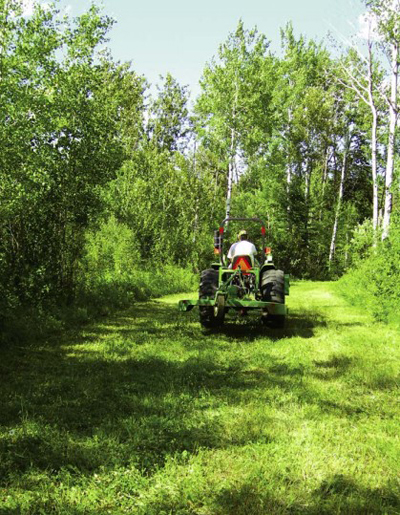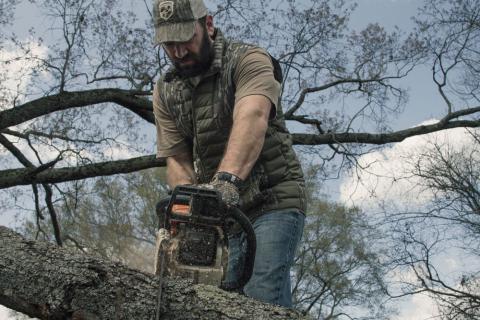Dave Edwards | Originally published in GameKeepers: Farming for Wildlife Magazine. To subscribe, click here.

soil. Wildflowers are an excellent utilization of roadsides.
There are many ways to improve, enhance, or create quality wildlife habitat on your property. Which management practices you should implement obviously depends on the limiting habitat types and factors of your property as well as your specific land management goals. I am fortunate to be able to travel around the country helping landowners assess limiting factors of their property to determine which habitat management strategies or practices will provide the most benefit to their wildlife. In my travels to these properties, I get to see who’s doing what and where. Some of the most common wildlife habitat management practices I’ve observed include timber management (such as tree planting, thinning and clear cutting), field edge management, burning, herbicide applications to promote quality understory within forests, and of course, various types of food plots. However, one of the most overlooked land management strategies that I’ve noticed is managing roadsides for wildlife.
How many miles of roads exist on your property? Even on relatively small properties, there are usually several miles of road and many opportunities to significantly enhance wildlife habitat by simply managing the small areas on the shoulders of these roads. Managing these areas add up and can result in many acres of additional quality wildlife habitat on your property. For the lack of creativity, I simply call this management practice “Roadside Management”.
So what is Roadside Management or a Roadside Management Zone (RMZ)? RMZ simply refers to areas along a road that are actively managed for wildlife and aesthetics. A variety of habitat management strategies are often implemented in these areas to increase habitat diversity, wildlife cover types, and food availability. The width of the “management zone” will vary depending on the specific features of the road and surrounding habitats you are managing, but is generally 20 feet to 40 feet wide. Sometimes you are able to manage both sides of the road, sometimes you’re not (and that’s ok). The goal is to take advantage of as much roadside as possible to enhance the wildlife value of the area.
Creating and Establishing Roadside Management Zones
I’m sure you’re already thinking of areas on your property where you can manage roadsides to improve wildlife habitat. So where do you start? Obviously, the first thing to do is to identify areas along your road system that will lend itself to management. If you’re thinking “I don’t have any roads that are open enough to do this” or “I have trees along all my roadsides,” don’t worry. If this is the case, your property is a perfect candidate for “roadside management” and wildlife will certainly benefit by managing roadsides.
As part of the initiation of a roadside management program, roadsides often need clearing to remove brush, small trees, and other obstacles that would prevent managing the area. The type of equipment needed varies depending on the obstacles. In some cases, a chainsaw and bush hog is all you will need to remove the vegetation and small trees so that you can “manage” the roadside. However, in most cases, a small dozier or mulching machine is the preferred equipment.
If you have a pine plantation along the road, you can remove the first two rows of trees during the next thinning. If you have clear-cuts that will be replanted in pines, establish RSZ’s now. Although the clear-cut will provide quality habitat for the first three to five years, once the trees mature you will be glad you “saved” the roadside to manage. When clearing roadside management zones, do not take out all the mature trees. If I am truly clearing an RMZ, I identify (flag) trees that I want to keep so that they are not accidentally cut down during the operation.

road or trail-sides. They provide one of the best cover options
available to numerous species of wildlife. This stand of Little-
bluestem offers great nesting cover for turkeys, excellent
bedding for whitetails and superb escape cover for all wildlife.
I try to keep mature oaks because they produce acorns, but more importantly provide shade which will help conserve soil moisture in the RMZ. They also add aesthetic value to the roadside. However, if your roadside or surrounding habitat is nothing but mature oaks that are relatively dense, you will need to remove some of them to open the canopy up and allow sunlight to reach the ground to promote plant growth along the roadside. The goal of the initial clearing or establishment of roadsides is to create areas that you can manage and maintain with a mower, disk, and possibly fire.
Managing Roadside Management Zones
Once RMZ’s have been identified and established you have many management and maintenance options. The management strategies employed will depend on your property management goals. For example, if you were primarily interested in managing deer you may consider planting fall and summer food plots on portions of the RMZ’s and maintaining fawning cover of tall grass and other vegetation on other portions. If you are managing for turkeys, you would likely manage RMZ’s for quality nesting habitat and brood-rearing areas. On most properties, I create, manage, and maintain a diversity of habitats along RMZ’s. Most RMZ strategies will benefit the game animals (deer, turkey, quail, rabbits, etc.), but if you are particularly interested in a specific species you can tailor your management to provide the most benefit for that animal. The following are a few of the management strategies that I often use in roadside management zones:
Perennial food plots—The goal of perennial food plots is to provide a year-round quality food source for deer, turkeys, and many other wildlife species. White clovers such as Durana, Patriot, Advantage, Osceola, or Ladino clovers grow well in RMZ’s because these areas generally have a good bit of shade, which is important during hot and dry summers. The species of clover you use will depend on the soil types and region of your property. With proper management, white clovers can last 3-5 years or longer without replanting.

or trail itself can be used for production. Clover Plus can be
planted on the trail and maintained just like a long, skinny
food plot.
Fall attraction plots—As the name implies, the goal of these plots is to attract animals for viewing or hunting. They are also planted to provide quality nutrition during the fall and winter months. My attraction plots often include winter wheat, oats, crimson clover, and arrowleaf clover. This seed blend grows well in a variety of soil types and is very attractive to deer, turkeys, and other wildlife. The reseeding annual clovers extend the life of the food plot and will produce forage through early summer in most regions. The clovers are also added because they produce abundant flowers in the spring which attracts insects for young turkeys and quail (due to protein requirements of young turkeys and quail, insects compose the majority of their diet during the first few weeks of life). Fall attraction plots can also add hunting opportunities on your property. If well designed, RMZ’s planted in fall annual food plots are great places to catch a big buck off guard. Besides hunting, this management strategy is a good way to increase wildlife viewing opportunities while riding around your property. Who doesn’t like to see deer, turkeys, or rabbits bouncing around their property as they ride through?
Summer food plots—The goal of summer food plots in RMZ’s is to provide quality food sources for wildlife as well as nesting and brood rearing cover for turkeys and quail and fawning and bedding cover for deer. Food plot species options in summer food plots are numerous and can certainly be geared towards the species of concern. For deer, I generally plant a mixture of legumes (e.g., cowpeas, soybeans, lablab, etc.) and what I call “ladder crops” (corn, sorghum, tall millets, etc.). The purpose of the ladder crops is to provide vertical support for the legumes to climb on. If my target species is birds such as turkey or quail, I generally plant a mixture of seed-producing crops such as millets (pearl, Japanese, browntop, dove proso, etc.), grain sorghum or milo, corn, and Egyptian wheat. These crops produce abundant seeds for the birds. However, if possible, I leave the crop stubble through the next spring. The stubble provides excellent winter and nesting cover for quail, turkeys, and other birds. Many landowners plant various types of summer plots in RMZ’s that benefit a variety of wildlife.
Wildflowers—Your first impression to my recommendation of planting wildflowers is probably “WILDFLOWERS? We’re not growing daisies…we’re growing deer,” so let me explain. Wildflowers serve three purposes on your recreational property:
- They add inviting aesthetics along RMZ’s that encourage the “I’m outdoors warm & fuzzy feelings” (don’t tell anyone I said that!)
- The flowers attract a plethora of insects which are an important component of turkey and quail diets. It really is amazing to see the number of insects in wildflower areas. If you get a chance, stop along the side of a highway with wildflowers and take a short walk through them. Insects will be jumping, crawling, and flying everywhere.
- RMZ’s planted in wildflowers are a great place to stop on the way back to the camp when you’re in the doghouse for hunting so late! “Redneckroses” have saved me more than once! There are many varieties and types of wildflowers. I recommend contacting a seed dealer to determine which mix will work best for you. Although there are shade-tolerant wildflowers, most will do best in full sunlight.

astatically pleasing plants also provide attraction for
pollinating insects which are vital to crop production, as well
as the best in bugging habitat for turkeys, pheasants, quail
and other birds.
Native Warm Season Grasses—Native warm season grasses (NWSG) have gotten a lot of press lately and rightfully so. Although NWSG’s alone do not provide a food source, if properly managed with strip disking and fire, they will have associated desirable weeds that will benefit wildlife as a food source. NWSGs are best known for the cover they provide for deer, nesting cover for turkeys, and general quality habitat for quail (bare ground, aerial cover from predators, weedy food sources, etc.). NWSG seeds often exist in the natural seed bank and can be stimulated to germinate by management such as herbicide, light disking, and fire. Once established, NWSG areas will require maintenance via fire and herbicide to persist and keep trees and other brush from encroaching.
Maintain Natural Early Successional Vegetation—The goal of this management approach is to provide natural food and cover for wildlife. Although it may not be the most beneficial management strategy of those I have mentioned, this is the least expensive and easiest to employ. Mowing, disking, and fire are the primary tools used to maintain and manage natural areas along roadsides. I have had great success in establishing desirable weeds for wildlife (such as ragweed) by simply lightly disking the areas during the fall. Other management includes liming, fertilizing, burning, and select herbicide applications to promote desirable natural vegetation. The objective is to control trees and other shrubs that will be trying to reestablish and maintain the area in relatively low growing desirable grasses and weeds. These areas will be used by deer, turkeys, and quail for cover and food throughout the year.
Enhance RMZ’s with fruit-bearing trees and shrubs—there are many fruit-bearing trees and shrubs (hard and soft mast) that are beneficial to wildlife and will help diversify food sources across your property. Regardless of the overall RMZ strategy, you employ, fruit-bearing trees and shrubs can be added and will provide additional food sources, shade, and enhanced aesthetics of the RMZ. Commonly planted species include sawtooth and dwarf chinquapin oaks, Chinese chestnuts, a variety of apples and pears, crab apple, plums, and autumn olive. Management of these species include controlling competing grasses and weeds while trees are young, pruning, and an annual dose of fertilizer
Conclusion
While managing other core habitats of your property is paramount, managing RMZ’s will help you maximize the wildlife and aesthetic value of your property. For some reason, this is a management strategy that is often overlooked by landowners but is certainly one that should be considered. As you’re riding around your property this hunting season, be thinking of areas along roads where you could create and manage RMZ’s. Devise a plan over the winter and get started early next spring putting your plans into action. You will be glad you did…and so will the wildlife.





























